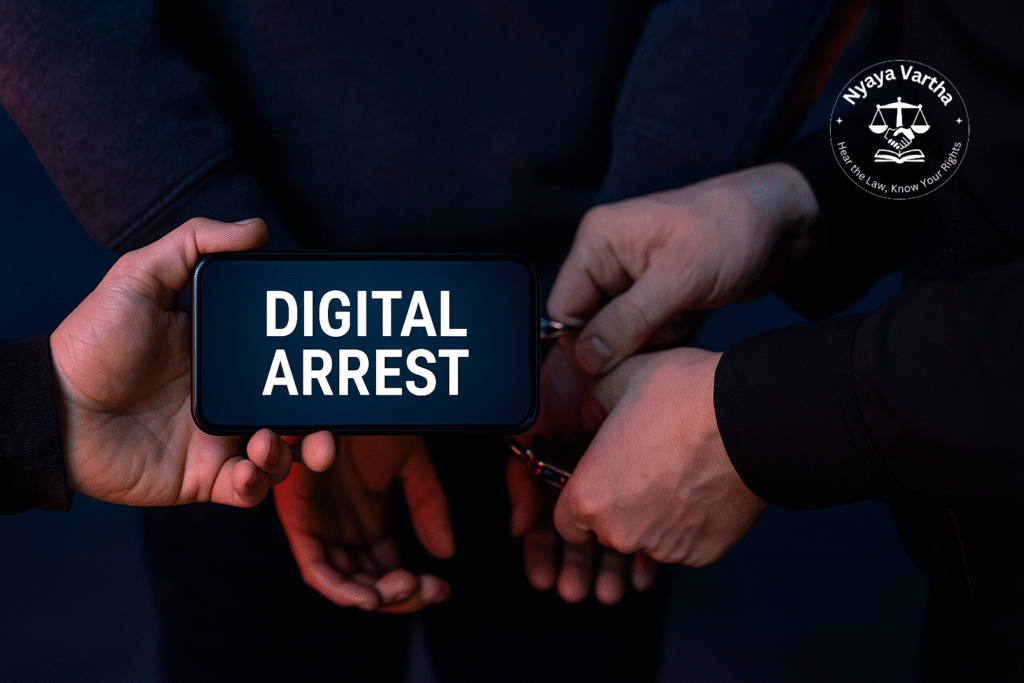Digital Arrest: A Modern-Day Cyber Scam
In the age of rapid digitalization, a new and alarming cyber scam has emerged, known as “digital arrest.” This is not a legitimate legal procedure but a sophisticated fraudulent tactic used by criminals to extort money from unsuspecting victims by leveraging fear and intimidation. The term “digital arrest” itself is a complete fabrication and has no basis in Indian law or any legal framework.

What is Digital Arrest?
Digital arrest is a form of cybercrime where fraudsters impersonate law enforcement officials or government authorities (such as the CBI, ED, Customs, or even Interpol) to trick individuals into believing they are under a virtual arrest. The scam typically begins with an unexpected phone call, message, or video call.
Modus Operandi: How the Scam Works
- Initial Contact: The scammer contacts the victim, often via a VoIP call or WhatsApp, and poses as a high-ranking official. They use fake caller IDs and official-sounding numbers to appear credible.
- Creating Panic: The victim is falsely accused of a serious crime, such as money laundering, drug trafficking, or involvement in illegal activities linked to their bank account or Aadhaar card. The scammer’s tone is authoritative and threatening, designed to create immediate panic and confusion.
- Digital Isolation: The victim is often coerced into a video call and told to stay on the line, with their camera and microphone on, essentially “digitally arresting” them and preventing them from contacting family, friends, or a lawyer.
- Fabricating Evidence: To make the threat more convincing, scammers may send fake documents, doctored videos, or fabricated “arrest warrants.” They might even use deepfake technology or a backdrop resembling a police station to add to the illusion.
- Coercion and Extortion: The scammer then demands a “security deposit,” “fine,” or “bail amount” to avoid immediate legal action, freezing of bank accounts, or cancellation of their passport. They pressure the victim to transfer money instantly via digital payment methods like UPI, cryptocurrency, or bank transfers.
- Disappearance: Once the victim transfers the money, the scammers disappear, leaving the victim to realize they have been defrauded. The extorted funds are quickly laundered through a network of “mule accounts” and often transferred to offshore locations.
Key Red Flags and How to Protect Yourself
- No “Digital Arrest” in Law: The most crucial thing to remember is that there is no provision for “digital arrest” under Indian law. Real law enforcement agencies will never conduct an investigation or demand money over a phone call or video call.
- Urgency and Pressure: Legitimate authorities follow a proper legal procedure. Scammers always create a sense of urgency and pressure the victim to act immediately without verifying the claims.
- Demand for Money: Government agencies and police will never ask for payments via digital wallets, UPI, or cryptocurrency to avoid arrest.
- Suspicious Contact: Be wary of unexpected calls or messages from unknown numbers, especially if the caller claims to be from a government agency.
- Do Not Share Personal Information: Never disclose sensitive information like your Aadhaar number, PAN details, bank account credentials, or OTPs over the phone.
What to Do if You are Targeted
- Stay Calm: Do not panic or give in to the pressure tactics.
- Disconnect the Call: Immediately end the call and block the number.
- Verify, Don’t Comply: If you have any doubt, verify the claims by contacting the concerned agency directly through their official website or helpline.
- Report the Incident: Report the scam to the National Cybercrime Helpline (1930) or file a complaint on the National Cybercrime Reporting Portal.
- Inform Your Bank: If you have shared any bank details, inform your bank immediately to secure your accounts.
Awareness is the best defense against such sophisticated scams. By understanding the modus operandi and being vigilant, you can protect yourself and your loved ones from becoming a victim of “digital arrest.”
